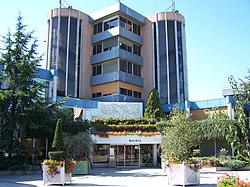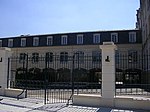André Mignot Hospital
1981 establishments in France20th-century architecture in FranceBuildings and structures in Île-de-FranceEuropean hospital stubsHospital buildings completed in 1981 ... and 3 more
Hospitals established in 1981Hospitals in Île-de-FranceTeaching hospitals in France

The André Mignot Hospital is a celebrated teaching hospital in Le Chesnay. Part of the Centre Hospitalier de Versailles and a teaching hospital of Versailles Saint-Quentin-en-Yvelines University.It has been created in 1981. It was named in honour of André Mignot, French Politician and Lawyer.
Excerpt from the Wikipedia article André Mignot Hospital (License: CC BY-SA 3.0, Authors, Images).André Mignot Hospital
Rue de Versailles, Versailles
Geographical coordinates (GPS) Address Nearby Places Show on map
Geographical coordinates (GPS)
| Latitude | Longitude |
|---|---|
| N 48.8250676 ° | E 2.1280533 ° |
Address
Rue de Versailles 116 bis
78150 Versailles, Le Chesnay
Ile-de-France, France
Open on Google Maps








